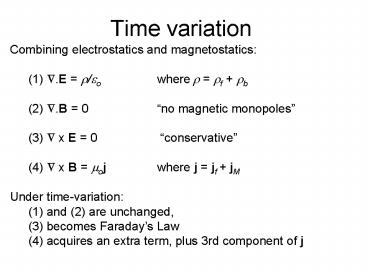Time variation - PowerPoint PPT Presentation
1 / 25
Title:
Time variation
Description:
Ampere's Law. Problem! ... Ampere's law inconsistent with the continuity equation (conservation of charge) ... suggests 2nd Form. Extending Ampere's Law to H ... – PowerPoint PPT presentation
Number of Views:52
Avg rating:3.0/5.0
Title: Time variation
1
Time variation
Combining electrostatics and magnetostatics (1)
?.E r/eo where r rf rb (2) ?.B 0 no
magnetic monopoles (3) ? x E 0
conservative (4) ? x B moj where j jf
jM Under time-variation (1) and (2) are
unchanged, (3) becomes Faradays Law (4)
acquires an extra term, plus 3rd component of j
2
Faradays Law of Induction
emf x induced in a circuit equals the rate of
change of magnetic flux through the circuit
3
Displacement current
Amperes Law
Continuity equation
Steady current implies constant charge density so
Amperes law consistent with the Continuity
equation for steady currents Amperes law
inconsistent with the continuity equation
(conservation of charge) when charge density time
dependent
4
Extending Amperes Law
add term to LHS such that taking Div makes LHS
also identically equal to zero The extra
term is in the bracket extended Amperes Law
5
Illustration of displacement current
Discharging capacitor
6
Displacement current magnitude
- Suppose E varies harmonically in time
w 10.19 rads-1 for eo?E/?t to be comparable to
sE
7
Types of current j
Total current
- Polarisation current density from oscillation of
charges in - electric dipoles
- Magnetisation current density variation in
magnitude of - magnetic dipoles in space/time
8
1st form of Maxwells Equations
all field terms on LHS and all source terms on
RHS The sources (r and j) are multiple (free,
bound, mag, pol) special status of free source
suggests 2nd Form
9
Extending Amperes Law to H
?D/?t is displacement current postulated by
Maxwell (1862) to exist in the gap of a capacitor
being charged In vacuum D eoE and
displacement current exists throughout space
10
2nd form of Maxwells Equations
Applies only to well behaved LIH media Focus on
sources means equations (2) and (3)
unchanged! Recall Gauss Law for D In this
version of (1), r ? rf and eo ? e Recall H
version of (4) In this version of (4), j ?
jf , also mo ? m and eo ? e
11
2nd and 3rd forms
LHS 2nd form, free sources only, other sources
hidden in permittivity and permeability
constants RHS 3rd form (Minkowsky) free sources
only, mixed fields, no constants
12
Electromagnetic Wave Equation
First form
13
Electromagnetic Waves in Vacuum
Dispersion relation
speed of light in vacuum
14
Relationship between E and B
15
Plane waves in a nutshell
16
EM Waves in insulating LIH medium
w
Slopec/n
w ck/n 2pc/nl
k
Dispersion relation
Less than speed of light in vacuum e,m complex in
general, real (as has been assumed) if hnltltEg
17
Bound Charges
Bound charge displacement xB Or velocity vB
versus time
Phase relative to driving field vs frequency
18
Free Charges
For a free charge, spring constant and wo tend to
zero
19
Dielectric susceptibility
20
EM waves in conducting LIH medium
21
EM waves in conducting LIH medium
EM wave is attenuated within skin depth in
conducting media NB Insulating materials become
conducting when radiation frequency tuned above
Eg
22
Energy in Electromagnetic Waves
Energy density in matter for static fields
Average obtained over one cycle of light wave
23
Energy in Electromagnetic Waves
Average energy over one cycle of light wave
Distance travelled by light over one cycle
2pc/w ct Average energy in volume ab ct
24
Energy in Electromagnetic Waves
25
Poynting Vector
N E x H is the Poynting vector Equal to the
instantaneous energy flow associated with an EM
wave In vacuum N wave vector k Example If
the E amplitude of a plane wave is 0.1
Vm-1 Energy crossing unit area per second is































